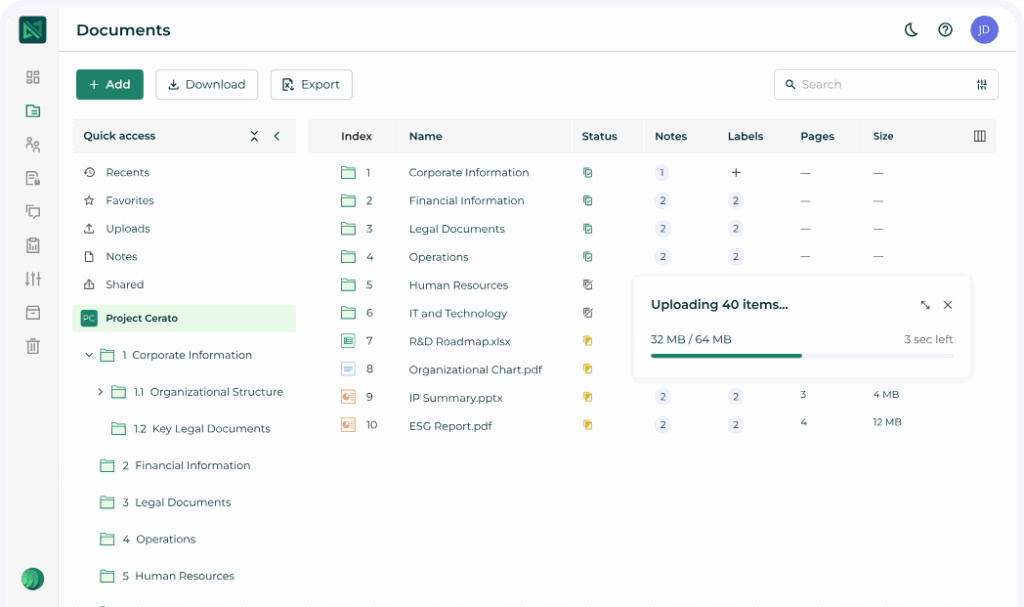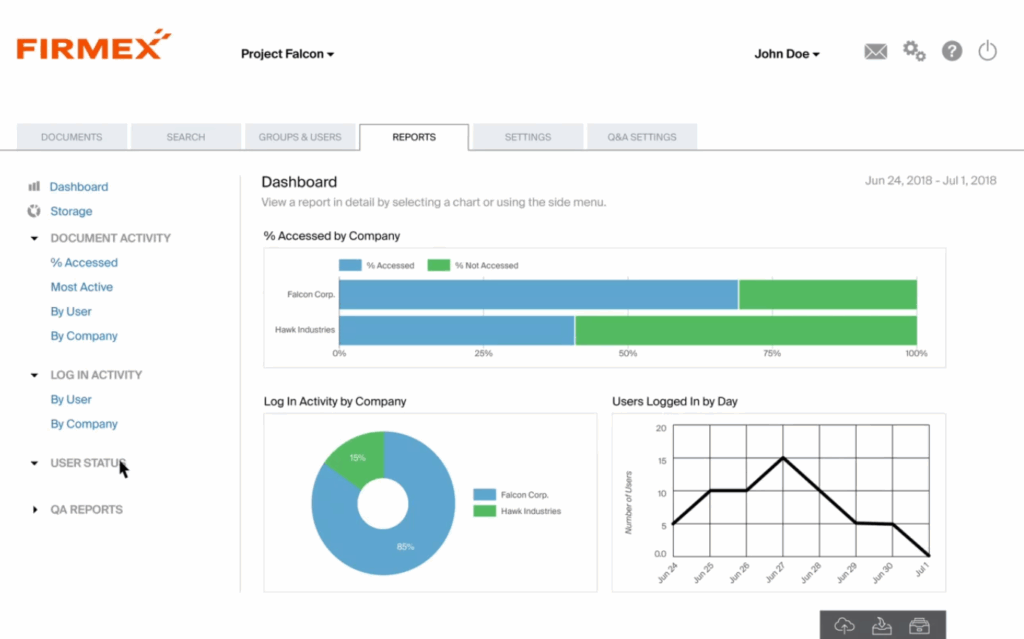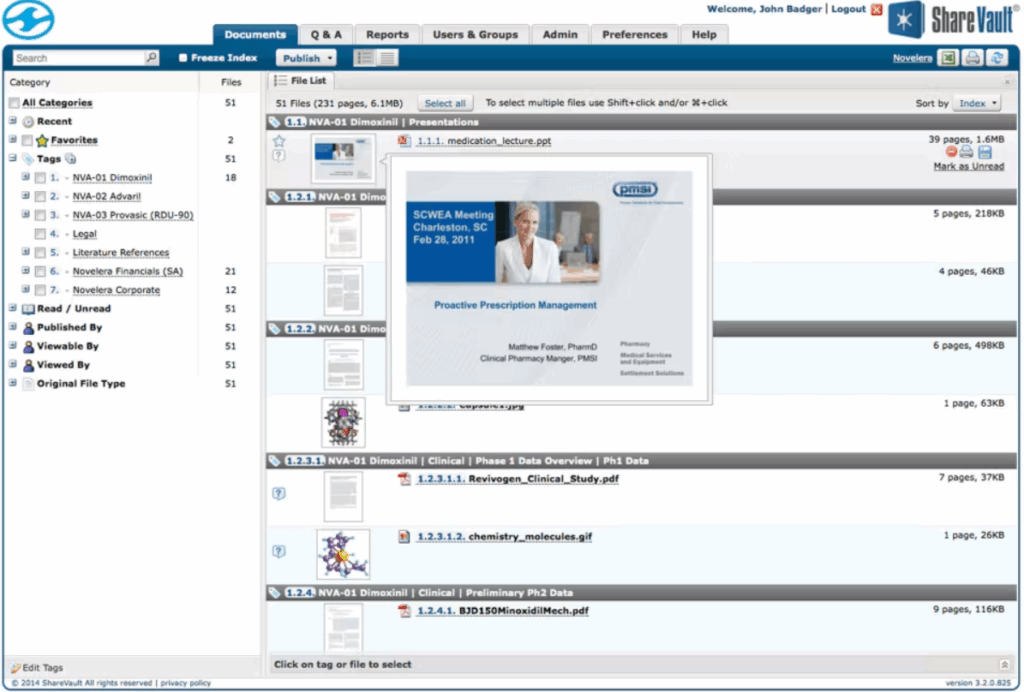

Trusted by over 34,000 companies, DocSend makes sharing documents simple, secure, and insightful. Users appreciate its intuitive interface, seamless document management, and powerful tracking features. From monitoring engagement to controlling access, DocSend keeps presentations effective and sensitive documents protected.
Yet, even a platform this strong isn’t one-size-fits-all. Some teams need advanced collaboration, deeper permissions, or more specialized features, driving them to explore alternatives.
In this guide, you will explore:
- Six best alternatives to DocSend, including their most powerful features, strengths, and trade-offs
- Which platforms are best suited for different team needs, from fundraising startups to legal departments and enterprise project teams
- Key use cases to help you match your workflow requirements with the right solution
- Guidance on migrating from DocSend, covering file transfer, analytics, permissions, and user onboarding
- Best practices and tips to ensure a smooth transition to another tool
Why consider alternatives to DocSend?
Before exploring DocSend’s drawbacks, it’s important to note that the solution is widely regarded as a highly effective and reliable tool. Based on user reviews, the platform is frequently praised for its strong usability and visibility features. In particular, users value its easy document management paired with helpful usage insights and secure access control.
However, the following concerns drive teams to explore alternative virtual data room providers:
1. Advanced features locked behind expensive plans
Users note that capabilities such as custom branding, data rooms, advanced analytics, and deeper CRM integrations are only available on higher-tier plans. This can limit smaller teams or early-stage startups that need these features but can’t justify the upgrade cost.
2. Pricing that scales dramatically
DocSend’s pricing is frequently described as expensive, especially given its target market of startups and small teams. There is no free plan, upgrades are costly, and the price escalates quickly as new features become available.
Cost-efficiency analysis of DocSend
DocSend’s pricing structure reveals a platform that becomes more expensive as users require advanced security, branding, analytics, and data-room capabilities. At first glance, the Personal plan ($10/user/month) is reasonably priced for secure link sharing and basic analytics. However, this plan doesn’t offer multi-file sharing, advanced analytics, branding options, and provides only four electronic signatures per month.
The Standard plan ($45/user/month) is the first tier suitable for professional use. Even here, many expected enhanced features, such as folder-level security and watermarking, are still unavailable.
For teams needing more advanced data room functionality, the price jumps sharply:
✔️Advanced: $150/month for 3 users
✔️Advanced data rooms: $180/month for 3 users
*Each additional user on these plans costs $60/month
Given that these tiers still offer only lightweight and enhanced data rooms, not full VDR functionality, the price-to-feature ratio becomes less attractive for M&A teams, legal departments, and enterprises that require more robust compliance, reporting, and granular control to manage the same document across multiple users.
3. Usability friction in certain areas
Although the platform is generally easy to use, users highlight the following shortcomings:
- A clunky interface when organizing folders or updating links
- Occasional lagging, especially during screen-sharing or live presentations
- A less-optimized mobile app, especially for reading long documents
- Underdeveloped video-sharing capabilities
- A document viewer that works best with PDFs, with limited support for other file types
These issues aren’t deal-breakers for most users. At the same time, they may impact teams that rely on specific functionality, including mobile workflows, live pitching, and mixed file formats.
Before you start comparing data rooms: DocSend quick reference
| Category | Value |
|---|---|
| G2 user rating | 4.6 (based on 564 reviews) |
| UpGuard security rating | 804 / 950 |
| Primary DocSend use cases | ○ Cloud storage, ○ Sending large files, ○ Video review, ○ Signing documents, ○ Sharing files |
| Main DocSend pros | Exceptional ease of use |
| Other benefits/features | ○ Easy document management ○ Insights on viewer engagement ○ Enhanced presentation effectiveness ○ Access control features |
6 best DocSend alternatives to consider
Below are six top DocSend competitors worth evaluating. For each, we’ll walk through key use cases, core features, and the strengths and trade‑offs so you can determine which solution is the best fit for your team.
1. Ideals
🔵 G2 rating: 4.7 (based on 711 user reviews)
🔵 UpGuard security rating: 948 / 950

Ideals is an advanced, easy-to-use platform designed for seamless collaboration across various industries. Independently certified with top security standards, the solution provides robust protection across processes, applications, infrastructure, and personnel. Thus, users get full confidence in their data security.
| Main use cases | Key features | ✅ Pros | ❌ Cons |
| ○ Financial services ○ M&A sell-side ○ M&A buy-side ○ M&A advisor ○ Fundraising | ○ Granular 8-level permissions ○ Screenshot prevention with fence view ○ AI-powered redaction ○ Custom session timeout ○ Due diligence checklist ○ In-depth Q&A settings ○ Custom branding ○ Automated reminders ○ 30-second chat response | ○ Exceptional ease of use ○ Strong security features ○ Granular access control ○ Speed and reliability ○ 24/7 expert email, chat, and phone support ○ Q&A functionality ○ Multilingual interface ○ Excellent quality–price ratio | ○ May be pricey for early-stage startups |
❗Ideals data room vs DocSend
Choose Ideals if you need a fully featured, highly secure VDR with granular access control, advanced collaboration tools, and top-tier support for complex deal processes.
2. Ansarada
🔵 G2 rating: 4.5 (based on 223 user reviews)
🔵 UpGuard security rating: 806 / 950

Ansarada offers purpose-built document security software for managing high-stakes projects. Its virtual data room delivers advanced AI insights, automation, enhanced Q&A, and customizable workflows designed for complex activities such as business audits, tenders, and major transactions.
| Main use cases | Key features | ✅ Pros | ❌ Cons |
| ○ Sell-side M&A ○ Raising capital ○ IPO Due diligence ○ Strategic review ○ Targeted acquisitions ○ Document repository | ○ AI predictive analytics ○ Centralized task management ○ Secure file sharing ○ AI bulk redaction ○ Remote document self-destruct ○ Automated Q&A | ○ Highly user-friendly ○ Responsive customer support ○ Easy navigation for all parties involved ○ Strong client engagement and hands-on assistance ○ Comprehensive feature set supporting complex transactions | ○ Expensive compared to other VDR providers ○ Slow performance with large data volumes and redaction tasks ○ Insufficient document tracking solutions ○ Limited customization options for certain workflows |
❗DocSend vs Ansarada
Choose DocSend if you need a simple, fast, and cost-efficient tool for sharing documents externally without the structure of a full data room.
3. Firmex
🔵 G2 rating: 4.6 (based on 91 user reviews)
🔵 UpGuard security rating: 872 / 950

Firmex is a secure and flexible virtual data room trusted by thousands of businesses, with over 20,000 new rooms opened annually. It offers robust document protection, industry-leading customer support, and flexible pricing options.
| Main use cases | Key features | ✅ Pros | ❌ Cons |
| ○ Sell-side M&A ○ Buy-side M&A ○ Licensing & joint venture ○ Restructuring ○ Financing ○ Client extranets | ○ Redaction ○ View As (user perspective verification) ○ Single sign-on (SSO) ○ Q&A management tool ○ Email In (upload via email) ○ Template-based project creation | ○ Intuitive interface ○ Efficient document management ○ Quick setup for new projects ○ Robust security features ○ Responsive customer support | ○ Insufficient access control information for managing permissions ○ Poor UI design ○ Expensive, especially for multiple mandates or large file volumes ○ Occasional download issues and slow file transfers |
❗DocSend vs Firmex
Choose Firmex if you need a secure, feature-rich virtual data room with advanced document controls, redaction, and robust support for complex transactions.
4. Box
🔵 G2 rating: 4.2 (based on 5,108 user reviews)
🔵 UpGuard security rating: 904 / 950

Box is a leading Intelligent Content Management platform that lets users store, sign, and secure content in one AI-powered, end-to-end solution. Team can collaborate effectively, protect sensitive data with advanced security and compliance, and extend capabilities with 1,500+ integrations.
| Main use cases | Key features | ✅ Pros | ❌ Cons |
| ○ Financial services ○ State and local government ○ Small business ○ Education ○ Professional services ○ Life sciences ○ Nonprofit | ○ Anywhere, anytime desktop and mobile access ○ File preview (120+ file types in-browser) ○ Granular content access controls (7 permission levels) ○ Compliance with FINRA and SOX ○ Built-in security with watermarking and hiding collaborators ○ Integrations with 1,400+ apps | ○ Intuitive and user-friendly interface ○ Easy collaboration with teams and clients ○ Safe data access from anywhere ○ Structured data storage ○ Unlimited storage | ○ Expensive pricing ○ Slow performance ○ Syncing issues ○ Connectivity issues ○ Slow data upload |
❗DocSend vs Box
Choose Box if you need a robust content management platform with advanced collaboration, granular security controls, and extensive integrations for managing documents across your organization.
5. Clinked
🔵 G2 rating: 4.9 (based on 337 user reviews)
🔵 UpGuard security rating: 731 / 950
Clinked is a secure, cloud-based client portal and collaboration platform that streamlines communication, file sharing for deals, and project management within a protected environment. Its offerings include a Client Portal that is easily customizable for client collaboration, a fully Custom Portal built on Clinked’s secure infrastructure to meet specific business needs, and a Virtual Data Room designed for high-stakes document management.
| Main use cases | Key features | ✅ Pros | ❌ Cons |
| ○ Client management ○ Project management ○ Content management ○ Client portal ○ File sharing | ○ Activity stream and audit trail ○ Custom access permissions ○ Single sign-on (SSO) ○ Version control ○ Document watermarking ○ Zapier integrations (7,000+ apps, including Zoom, QuickBooks, Power BI) | ○ Easy to use with an intuitive interface ○ Strong security and privacy features ○ Reliable for due diligence document sharing ○ Smooth navigation with a good range of tools | ○ Mobile app functionality needs improvement ○ Limited automation ○ Steep learning curve due to many features |
❗DocSend vs Clinked
Choose Clinked if you need a secure, collaborative portal for managing client relationships, sharing files, and coordinating projects, especially when you want branded workflows, rich communication features, and document control in a shared workspace.
6. ShareVault
🔵 G2 rating: 4.6 (based on 81 user reviews)
🔵 UpGuard security rating: not available

ShareVault is a secure virtual data room designed to simplify how organizations share confidential documents with third parties. Trusted across billions of dollars in deal transactions, it’s a preferred solution for M&A, asset sales, fundraising, licensing and partnering, and board collaboration.
| Main use cases | Key features | ✅ Pros | ❌ Cons |
| ○ Buy-side M&A ○ Sell-side M&A ○ General corporate ○ Biopharma partnering ○ Fundraising | ○ Dynamic watermarking ○ Redaction ○ Screen capture blocking ○ Index auto-numbering ○ Detailed audit trail ○ Collaborative Q&A ○ Bulk drag-and-drop uploading ○ Integrations with SharePoint, OneDrive, Google Drive, Dropbox, Box, DocuSign, SSO providers, and a rich API | ○ Effective collaboration features for client and team communication ○ Easy to use with quick client onboarding ○ Seamless team collaboration ○ Efficient project and team management ○ Secure sharing capabilities | ○ Limited design and customization options ○ Learning curve for new users ○ Needs improved integrations with third-party tools ○ Missing features, e.g., chat options and organization tools ○ Limited mobile app usability compared to desktop ○ Confusing user interface in some areas |
❗DocSend vs ShareVault
Choose ShareVault if you need secure, full-featured virtual data room tools with advanced document protection, activity analytics, and support for complex processes like M&A and due diligence.
Note: All tables and comparisons in this guide are based on publicly available information from user review websites G2 and Capterra, as well as official provider websites. For specific feature details or inquiries, users should contact a specific provider or their sales teams for pricing.
Additional resources: Explore Intralinks competitors to uncover more secure document‑sharing solutions and see how the platforms we’re reviewing here stack up against other options.
Use-case recommendations
Below is a breakdown of competitor platforms to DocSend and their best fits for specific scenarios (based on the limitations users face with DocSend and the strengths of each solution).
1. For startups raising capital on a budget → Clinked or Ideals (depending on needs)
Early-stage teams often need branded client portals, simple file sharing, and smooth collaboration, but with more affordable data room costs and a better cost efficiency than DocSend’s higher pricing plans.
- Choose:
| ➔ Clinked if you want a customizable client portal, branded workflows, and collaborative project spaces. | ➔ Ideals if fundraising involves sensitive investor materials that require stronger permissions, watermarking, and advanced document protection. |
2. For M&A advisors, investment bankers, and corporate development teams → Ideals, Ansarada, or ShareVault
These teams handle large volumes of confidential documents, run complex due diligence processes, and require granular control and auditability, which is far beyond DocSend’s lightweight data rooms.
- Choose:
| ➔ Ideals when you need enterprise-grade security, high-granularity permissions, and fast, reliable performance for cross-border dealmaking | ➔ Ansarada for AI-powered workflows, automation, and predictive real-time insights that support IPO prep, major transactions, and strategic reviews. | ➔ ShareVault if you need a traditional, structured VDR trusted in M&A with deep document protection and detailed analytics. |
3. For legal teams and compliance-driven industries → Box or Ideals
Legal departments, compliance teams, and highly regulated sectors require audit logs, retention policies, secure file storage, and strict controls.
- Choose:
| ➔ Box if your priority is centralized document management across the whole organization, plus enterprise-grade security and compliance. | ➔ Ideals if you need VDR-style permissions, session control, redaction, and Q&A for formal processes like legal reviews. |
4. For project management teams → Clinked or Box
Teams coordinating internal and client-facing projects need task tracking capabilities, version control, and real-time collaboration.
Choose:
| ➔ Clinked if you want a fully branded client portal with integrated communication and project management. | ➔ Box if you need extensive integrations, structured content storage, and secure collaboration across multiple departments. |
5. For teams that need lightweight document sharing with engagement tracking → DocSend (or stay on DocSend)
If your needs are simple, such as sending decks, seeing who viewed them, and tracking engagement, this solution still works well.
Stick with DocSend if you don’t need multi-file data rooms, advanced security, or deep customization.
If you’re planning to choose one of the DocSend alternatives, you’ll need to migrate your files, settings, and analytics properly to avoid disruption. We’ve outlined the key steps, best practices, and tips to make the process smooth.
💡Additional resources: Check Datasite vs Donnelley/DFIN comparison to see which platform may fit your deal management needs.
How to migrate from DocSend
Here’s a structured approach:
1. Identify what to export
Before leaving DocSend, assess all content, including shared documents, links, and folder structures. Take inventory of the following:
- All uploaded files (PDFs, presentations, spreadsheets, multimedia)
- Existing link settings, expiration dates, and permissions
- Analytics and engagement data, if you plan to retain or export usage metrics
Consider exporting your documents in a structured folder hierarchy so that they can be easily mapped into your new platform.
2. Choose the right solution for replacement
Select a tool that matches your workflow and user needs. Consider the following factors:
- Security requirements (encryption, watermarking, external document access control)
- Collaboration and client-sharing features
- Document access analytics tool sets and reporting capabilities
- Integrations with existing systems (CRM, cloud storage, identity management)
3. Set up the new platform
This stage includes the following steps:
- Recreate folder structures and organize files for easy access
- Configure user roles, permissions, and security settings
- Apply branding, customizable templates, and automation features as needed
- Test links, access, and enterprise document collaboration features before full deployment
4. Migrate document analytics and tracking
DocSend provides engagement metrics (views, downloads, time spent). Most deal room alternative platforms offer their own analytics tools. While you may not transfer DocSend data directly, you can do the following:
- Export historical analytics for reference in reports
- Set up equivalent tracking in the new tool (e.g., user activity logs, page-by-page analytics, Q&A reports)
5. Train users and stakeholders
Onboarding is a critical step in a successful migration. Some providers, including Ideals, make this easier by offering full-scale onboarding led by experts. Thus, your team can quickly learn the platform’s navigation, collaboration tools, and secure document management practices. The recommended steps are as follows:
- Provide team training on the new platform’s navigation, secure cloud sharing for deals, and collaboration workflows
- Share best practices for secure data sharing, permissions management, and document workflow automation
- Create reference guides or short tutorials to minimize adoption friction
6. Monitor post-migration usage
After going live on the new platform, it’s essential to track adoption and performance to catch issues early. So, teams should take the following steps:
- Review analytics in the new platform to ensure all links, permissions, and notifications function correctly
- Check that workflows like automated Q&A, bulk uploads, and reporting are operating as expected
- Solicit feedback from users and adjust settings to optimize efficiency
Potential pitfalls to avoid
- Skipping a full audit of DocSend content, which can lead to missing files or broken links
- Overlooking user permissions, resulting in unauthorized access or restricted access for key collaborators
- Ignoring training needs, which can slow adoption and cause errors
- Failing to configure analytics, losing historical engagement insights
Best migration practices
- Conduct a phased migration if you manage multiple teams or clients
- Maintain a backup of all DocSend files before switching
- Engage your new provider’s support team early to assist with setup and migration
- Document the migration plan and timeline to ensure accountability
Follow these steps, and your transition from DocSend to a new platform will be quick and easy.
Key takeaways
- DocSend excels at simplicity and insights. Users praise its ease of use, intuitive document management, and tracking features that provide clear visibility into viewer engagement.
- While DocSend is ideal for lightweight sharing and engagement tracking, teams that require advanced permissions, robust data rooms, AI-powered workflows, or full collaboration tools may need alternatives.
- Secure document sharing platforms such as Ideals, Ansarada, Firmex, Clinked, Box, and ShareVault are the best alternatives to DocSend.
- Successfully switching from DocSend involves exporting files and analytics, setting up the new platform with proper permissions and workflows, training users, and monitoring adoption to avoid disruption.
Assess your team’s needs carefully and select the solution that best aligns with your deal flow, security requirements, and collaboration goals.
Recommended for you



